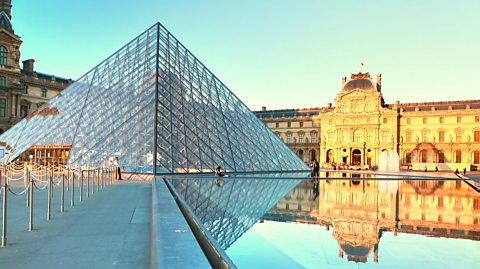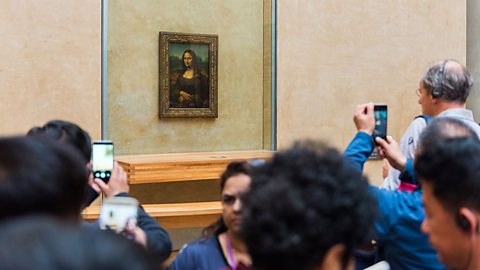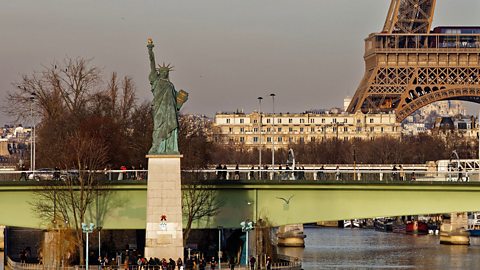Five fun facts about Paris
Paris is the capital city of France and a cultural and culinary hub. In 2024 it played host to its third Olympic Games. Paris, situated on the river Seine and with a population of over 2,000,000 people, has been a major centre of finance, diplomacy, commerce, and fashion since the 17th Century.
But did you know these five facts about Paris?
1. Paris has the world's largest museum and the most famous portrait!
The Louvre, a museum and art gallery in Paris, is the largest museum on earth with nearly 73,000 square metres of exhibition space - that’s more than the size of ten football pitches!
The Louvre was originally built in 1546 as a palace for the French royal family. The first resident of the palace was King Francis I. Francis, a lover of art, intended the Louvre to showcase his collection. Subsequent kings including Louis XIII and Louis XIV greatly expanded the crown's art holdings, with Louis XIV even acquiring the art collection of English king Charles I, after his execution in the English Civil War.
The collection remained mainly private until the outbreak of the French Revolution in 1789, and in 1793 the Louvre opened as a public art gallery. The first exhibition contained just 537 paintings, while today the museum displays more than 35,000 works of art. That means if you spent just 30 seconds looking at each piece, you would be in the museum for more than 200 days.

Arguably the most famous artwork housed within the gallery is the Mona Lisa (La Gioconda in Italian), painted by Leonardo da Vinci sometime between 1503 and 1519. The painting depicts a woman in a half-body portrait with the sitter’s position mostly turned toward the viewer, a groundbreaking idea at the time.
King Francis I, whom we met earlier, acquired the work after da Vinci’s death. It remained in the royal collection until the French Revolution. Following a brief period hanging in Napoleon’s bedroom, the Mona Lisa was installed in the Louvre Museum at the beginning of the 19th century.
She didn’t live there peacefully ever after. In 1911 the Mona Lisa was stolen. People flocked to the Louvre to view the empty space where the painting had once hung. Several people were arrested in connection with the theft, including famous artist Pablo Picasso. Two years later the painting was found stashed in the false bottom of a trunk belonging to Vincenzo Peruggia, a glass fitter who had briefly worked at the Louvre fitting glass on a selection of paintings, including the Mona Lisa. Peruggia was arrested and the Mona Lisa took a tour of Italy before making its return to France.
During World War II the Mona Lisa was selected as one of the most vulnerable artworks for enemy capture and was evacuated to numerous locations in the French countryside, eventually returning in 1945 once peace had been declared. Since then, she has mostly remained within the gallery, aside for a few quick trips abroad including New York, Washington, Moscow, and Tokyo.
Today, more than 30,000 people view the painting each day the gallery is open.

2. Why is Paris known as The City of Light?
It might not be for the reasons you think…
In the early 19th century, Paris became the first city in Europe to use gas lighting to illuminate its streets, thus earning its name as the City of Light. However, that’s not the only reason Paris earned this nickname…
In the 17th and 18th centuries an intellectual movement known as the Enlightenment became popular within the western world. The key idea behind the movement was the use and celebration of reason, with the core goals for humankind being knowledge, freedom, and happiness. Important figures of the movement included Francis Bacon and Benjamin Franklin.
But what was the key location for the great change in how humanity thought about the world? Paris, of course! The cafГ©s and coffeehouses of 18th century Paris provided a place for intellectual conversations where philosophers developed new ideas and theories.
To put it simply, Age of Enlightenment + Paris = The City of Light.
3. The first commercial screening of a projected film...
…happened in Paris.
In the late 19th century, the race to develop technology for capturing and displaying moving pictures was well underway. The two countries leading the charge were France and the USA.
American Thomas Edison and his modestly self-titled Edison company were the first to produce a moving picture for the masses – well, masses of one. His device, the Kinetoscope, enabled one person at a time to view moving pictures.

But the first people to present projected moving pictures to a paying audience, in anything like the cinemas we have today, were the LumiГЁre brothers in December 1895 in Paris, France. The device they developed and used was called the °дѕ±ІФГ©іѕІ№іЩґЗІµ°щІ№±иіу±р; it was a camera, a projector and a film printer all in one.
Unlike the electrically powered Kinetograph camera, which was used to create the film for Edison’s Kinetoscope, the °дѕ±ІФГ©іѕІ№іЩґЗІµ°щІ№±иіу±р was hand-cranked so films could be shot anywhere - in the middle of bustling cities or deep in the wilderness, sometimes even from moving vehicles. This portability meant the technology quickly caught on and the LumiГЁres swiftly established agencies in many countries - but the place where it all began was the Salon Indien du Grand CafГ© in Paris.
4. There are Statues of Liberty dotted all over Paris
Few things are more American than the Statue of Liberty, right?
Well, not quite: the familiar 93-metre monument that lives in New York City was originally a gift from the people of France to commemorate the friendship between their countries.
The statue is made from copper sheets, bent into shape using hammers and pieced together over an enormous structure of steel supports. The completed statue was presented to the American minister to France in Paris on 4th July, 1884. In 1885 the statue was disassembled and shipped to New York City.
With one famous statue shipped across the Atlantic, many more popped up to fill her place. Today there are several replicas of the statue located all over Paris, the largest on a small man-made island on the river Seine called ГЋle aux Cygnes. This smaller replica, standing 11.5 metres tall, was actually a gift from America to France in return for their previous statue-based generosity. Nice!

5. Paris is the second city to have hosted three summer Olympic Games

Paris previously hosted the Olympic Games in 1900 and 1924. 2024 is the year it joins London in the exclusive club of three-time Olympics hosts.
Quite a bit has changed in the 100 years since Paris last hosted the games. Back then, only 44 countries took part and events included competitive architecture and painting! There was also a music competition, but sadly no medals were awarded. Another anomaly is that no gold medal was awarded for the architecture competition, despite silver and bronze going to Hungary and Monaco respectively.
The 1924 games were also the first to feature a closing ceremony in the form that we know it today, and the first to feature an Olympic village to accommodate the athletes taking part.

Jump forward to 2024, and over 200 countries now compete in events including the new addition of break dancing, or breaking. Although, sadly, there will be no painting or architecture events in this edition…
Where can I find out more about France?
If these Parisian facts have whetted your appetite for all things French, you may enjoy heading to our KS2 and KS3 French games.
If you're more interested in the culture, then check out festivals and customs throughout the French-speaking world.